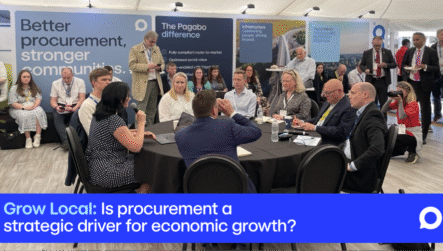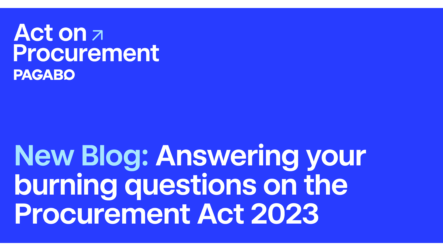
Frameworks have quickly become the preferred route to market for public sector projects and this momentum will continue to soar as the Procurement Act 2023 came into effect on 24 February. Now, those procuring and managing frameworks, including the likes of Pagabo acting as an agent, must go beyond the basics to cut through the noise and pave the way for fair, practical and transparent procurement that serves the needs of contracting authorities, suppliers and agents equally.
Jonathan Oram, director of frameworks at Pagabo, which sets up and manages frameworks on behalf of public sector contracting authorities, explores the benefits of prioritising a flexible approach to help achieve this common goal.

A successful framework is one that helps the contracting authority to choose the best organisation to deliver the best value for the project at hand; one that’s backed up with a promise of quality and legal reassurance provided through the prior due diligence that’s essential before any awards are made.
Now, though, it’s not enough to just proudly showcase previously approved suppliers on each lot. More and more frameworks are launching, and standards are set to rise as the Procurement Act moves the industry closer towards the goal of achieving the ‘gold standard’ set out in the Construction Playbook.
Through frameworks, contracting authorities should be supported in making the best choice for their projects. Not doing so just won’t cut it in today’s market, especially with the need for competition essential in many contracts.
Here lies the difficulty – every job is unique and so will require a different company with relevant resources and experience, making it tempting to pack framework lots full of talented businesses.
However, having too many suppliers can easily become overwhelming and can dilute the demand, making it equally as unattractive for both the contracting authority and the contractor. Instead, there’s a balance to be found. The key to success is to be flexible and create a framework with processes around it that ensure this mindset is entrenched into every relevant touchpoint.
Refining the process
If a spanner could represent the tool you need for the job, then we view our frameworks as an adjustable spanner and will work with the contracting authority to ensure it fits their needs each and every time. To do this, it requires flexibility on a number of levels – this could be through offering a wide range of appointment options and contracts, such as Direct Award or New Engineering Contract (NEC), or through having the infrastructure in place to cope with the ups and downs of the market, and the vast disparity between each job.
One way we do this is through our use of a ‘reserve list’ on several of our frameworks. Through this structure, we may allocate nine places on each lot for example, six of which would form the ‘core’ suppliers, with the remaining three forming the ‘reserve list’. We were the first national framework provider to introduce the use of such lists several years ago, with their development being a response to the market.
We all remember the collapse of Carillion and, more recently, the collapse of ISG, both of which demonstrates that suppliers can go bust in unstable markets even when financials look robust. While evaluations for appointments examine financial stability in bidding parties, it would be wrong to ignore the somewhat turbulent economic waters of recent years. As of December 2024, new Insolvency Service figures showcase the construction industry to be the worst hit sector over the past year for insolvencies, making the element of rigorous financial checks more important than ever.
Plus, with an increase of work across the whole sector, we have seen resources at many contractors tied up, meaning they are not in a position to bid the work.
In both scenarios, the reserve list comes into its own – enabling competition for contracting authorities when core list suppliers do not provide enough competition by themselves, and providing a wider pool of suppliers should the worst happen for any organisation sitting in a core list position.
All bidders under core and reserve lists are allocated equally and with the same criteria, and in essence reserve lists have helped to refine the way we manage further competitions and, in turn, mitigate any risk due to market instability.
On the flip side, offering choice of too many suppliers from the start could deter many contracting authorities from running a further competition, adding more complexity to the labour-intensive process of evaluating a large number of returns. Skilled suppliers may also look to bid for a place on other frameworks where their chances of winning would be higher.
Value, on a wider level
There’s a lot to unpack as to why these shocking statistics have become reality and alongside protecting the contracting authorities, we know the frameworks we manage go some way in supporting the sector too, offering one solution to the wider challenge. As part of our commitment to pioneering transparent and ethical procurement, we have other processes that aim to create opportunities for our industry’s next generation and help the built environment sector to grow.
These include internal processes, such as offering detailed ‘bidder debriefs’ for every successful and unsuccessful contractor, explaining the reason for our decision and offering constructive feedback on how they can make their services stronger.
Our use of reserve lists also helps to boost engagement and encourage market brilliance when managing frameworks. Having the option to interchange between the core and reserve lists gives more businesses the chance to tender for exciting projects. They also go far deeper, generating social value through creating and safeguarding jobs and facilitating work placements and apprenticeships via successful and ethical procurement strategies.
This year and beyond, public sector procurement is only set to become more complex as concerns such as safety, security, quality and value for money remain front of mind for every project. The framework market is strong, but to make the right decisions it will pay off to dig a little deeper and search for frameworks that offer the level of flexibility required to meet the demands of the modern world.
Discover our frameworks
































